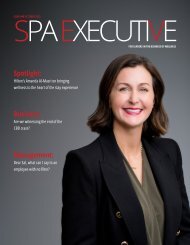Create successful ePaper yourself
Turn your PDF publications into a flip-book with our unique Google optimized e-Paper software.
Coon and Miller found that the samples did<br />
contain useful real-time information. For<br />
example, the urine showed changes in<br />
biomarkers with a connection to coffee and<br />
alcohol consumption, as well as a spike in ion<br />
intensity when one subject took<br />
acetaminophen. They were also able to<br />
measure the metabolic outputs from exercise<br />
and sleep.<br />
Designing a smart toilet that can<br />
recognize individuals<br />
The team is now designing a “smart toilet”<br />
that can recognize individuals and process<br />
samples from a variety of subjects, with plans<br />
to install the toilet in their research building<br />
and expand the user group.<br />
“We’re pretty sure we can design a toilet that<br />
could sample urine. I think the real challenge<br />
is we’re going to have to invest in the<br />
engineering to make this instrument simple<br />
enough and cheap enough. That’s where this<br />
will either go far or not happen at all.”<br />
Many potential applications<br />
The researchers believe there are many<br />
potential applications for the technology.<br />
Among them are testing how an individual<br />
metabolizes different types of prescription<br />
drugs, and testing whether people are taking<br />
medications properly and if they’re having the<br />
desired effect.<br />
Coon also believes the smart toilet could<br />
have major population health implications. “If<br />
you had tens of thousands of users and you<br />
could correlate that data with health and<br />
lifestyle, you could then start to have real<br />
diagnostic capabilities,” he said. He also said<br />
it might provide early warning of viral or<br />
bacterial outbreaks.<br />
Coon told Digital Trends, “Wearable devices<br />
that collect data continuously are disrupting<br />
healthcare in a positive way. However, they<br />
primarily rely on heart rate and step count.<br />
Toilet sampling of urine in the way we<br />
describe could monitor hundreds of<br />
compounds that can directly report on your<br />
metabolic health and lifestyle.” For example,<br />
he said, the measurements could inform on<br />
everything from chemical exposures to<br />
consumer products to metabolites indicative<br />
of inflammation.<br />
Clear applications for the spa of the<br />
future<br />
The technology has clear applications across<br />
the health and wellness sector, and for the<br />
spa of the future, as discussed in <strong>Spa</strong><br />
<strong>Executive</strong>’s report on the topic.<br />
In the report, futurist James Canton<br />
predicted, “A fusion of next generation<br />
wellness and health informatics is going to<br />
create a new era for spas. The information to<br />
which we will have access will allow spas to<br />
design personalized programs for<br />
enhancement and prevention. If I’m going on<br />
vacation for a week to a spa, I want to get to<br />
the next level of my health and wellbeing. I<br />
don’t want to just lose a few pounds, or just<br />
relax. I’d like to get some insight so I can live<br />
an extra, vital 20, 30 or more years.”


















